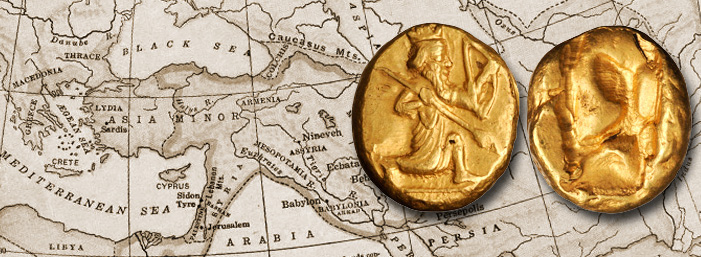
Coinage created in the Persian Empire was almost exclusively used for trade with the Greeks, and not for inter-imperial trade. The Persians maintained a system of direct exchange or contribution of services and natural goods. As such, coins were scarcely needed as a bartering tool. Most of the Persian Empire’s coinage was produced at Sardes, at the far western edge of the empire, as it was in close proximity to the Greeks. The gold pieces produced at Sardes for the Persians became known as Darics after their “inventor” Dareios. These pieces would be used to pay for Greek mercenaries. The gold Darics depicting the “Great King” of Persia would become nearly as famous throughout the Mediterranean world as the well-known Athenian Tetradrachms.
The coin’s design features the Persian Great King in a kneeling-running stance facing right. The bearded and mural crowned king holds in his right hand a spear with the tip pointed down and in his left hand, a bow. The reverse is an incuse punch design, iconic for the type. The coin is well centered, with the entire obverse design present. This coin was struck sometime during the reigns of Xerxes II, Sogdianus, Darius II, or Artaxerxes II (ca. 420 – 375 B.C.). This gold piece is truly impressive and is one of the many intriguing ancient numismatic pieces in our upcoming November Baltimore auction.
Look for this and other Ancient numismatic rarities in our upcoming November Baltimore Sale. Preview this impressive coin along with the rest of our auction this October. For details please refer to the Auction Schedule/Details link under Current Auctions at www.StacksBowers.com. To schedule an appointment, please call 800.566.2580. While our Stack’s Bowers and Ponterio November Baltimore sale is closed for further consignments, we are currently taking consignments of world and ancient coins for our January New York International, and April 2014 Hong Kong sales. If you are interested in consigning your coins and paper currency (whether a whole collection or a single rarity) be sure to contact one of our consignment directors.





